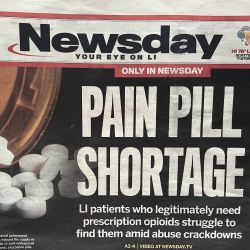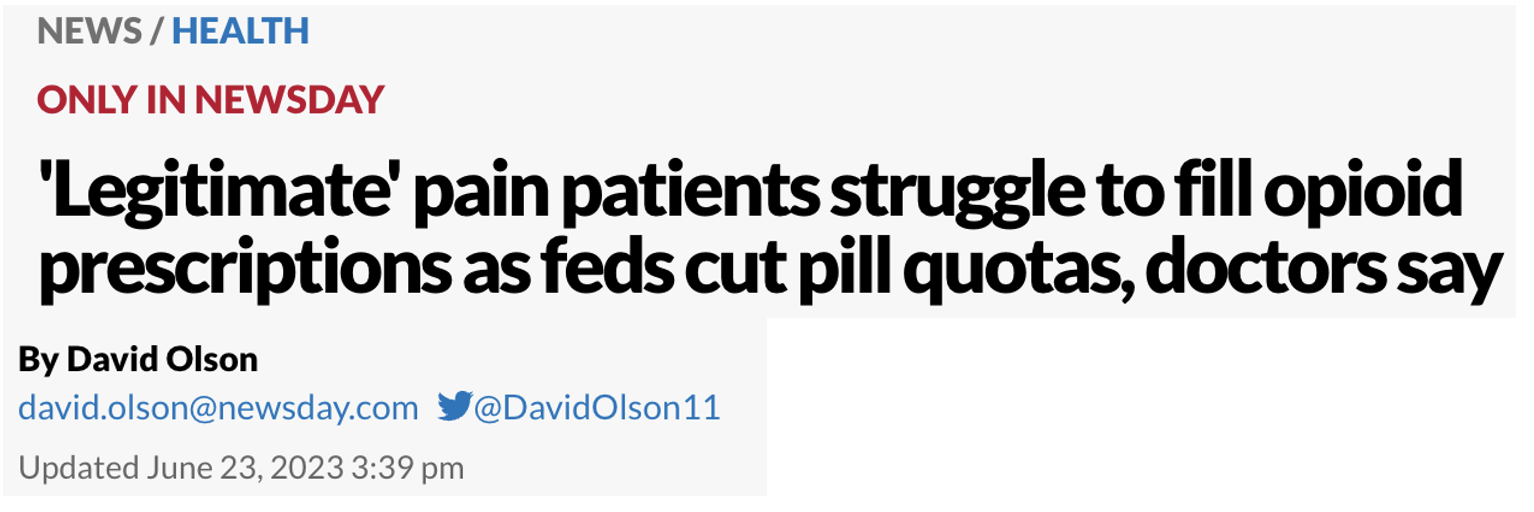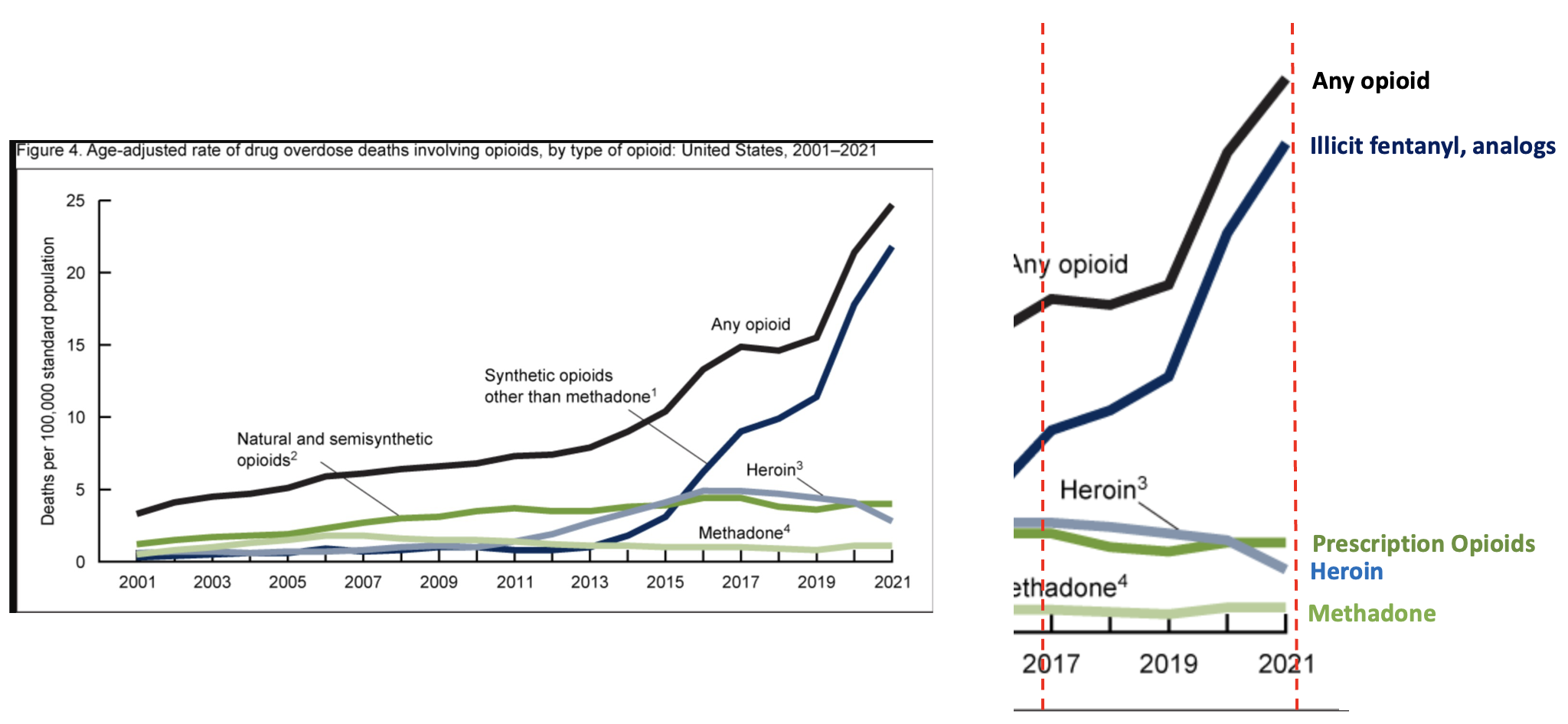Recently, Newsday's David Olson wrote about opioids in an honest way not often seen in mainstream media. He emphasized the harm caused by the “overcorrection of the pendulum” – the shortage of medically legitimate opioids caused by ill-advised restrictions on prescribing. He gives personal accounts of practitioners, pharmacists, and patients struggling to navigate the unforgiving terrain of new laws and policies. Thumbs up to Mr. Olson for this important article.

No, you are not hallucinating. The thumbnail photo is from my copy of Newsday, a highly-regarded Long Island-based newspaper with the 9th highest circulation in the US despite its regional focus.
This is not just another article; it's the front page of the Sunday edition from June 25th. The title of David Olson's article should be a sight for sore eyes to the millions of pain refugees, the powerless victims of an absurd and ruthless, drug policy that for years have been frustrated by the inability or refusal of the press to get past the "pills kill" mantra.

The difference from the typical obligatory anti-pill blather is eye-opening [my emphasis]:
A shortage of prescription opioids is causing people with severe pain to scramble to find their medicine, Long Island doctors and pharmacists say.
The federal government over the past decade drastically reduced the supply of legal opioid medication, in an effort to curb widespread abuse of the drugs.
But doctors, pharmacists and patients say those initiatives went too far: People who have a legitimate need for the medicine now often have a hard time finding it, and sometimes must endure more pain after they run out of pills.
Yes, Olson has written a rare, (at least for mainstream media) but important piece that is not singularly focused on addiction or overdoses. Instead, Olson, who covers healthcare for the paper, writes about the impact upon the real victims of the woefully misguided crackdown on prescription painkillers – the many patients who need but cannot get them.
The real damage
When millions of long-term users of high-dose prescription opioids are involuntarily tapered (or cut off entirely) from the medications that, in many cases, are keeping them functional or even alive, they are all but guaranteed to suffer. Even worse, many of these same patients have trouble obtaining even the reduced doses to which they were "assigned" thanks to the disastrous 2016 CDC "Guideline," which established low or very low quality evidence "recommendations" that (predictably) became law in most of the country.
Long Island, comprised of Nassau and Suffolk counties, has an "opioid problem," which – just like the rest of the country – is, in reality, a problem caused by illicit fentanyl, not prescription drugs. Yet, most journalists have been unable or unwilling to distinguish between the two. Olson does just that. He spoke to a number of people, some of whom have been directly impacted by our foolish drug policies...
“I have a dozen messages every day from people saying their pharmacy doesn’t have opioids...Continuing to throttle the legitimate supply is only hurting legitimate patients at the moment.”
Dr. Edward Rubin, a Long Island pain management specialist
“I’m in pain constantly...I’m sick and tired of every time you go to the drugstore, you don’t know if your medicine is going to be there or not...It’s just not right. People with legitimate pain who are using their medicine as prescribed are being “penalized” for those who abuse opioids."
John Douglas, Lake Grove, NY, a chronic pain patient
...and others who are indirectly impacted.
"[S]ometimes [I] can’t get certain opioids for days on end...The patient should not have to run around calling 30 different places to see if the drug is in stock."
Mukash Patel, a Long Island pharmacy owner
“[We] have been asked to walk a legal and ethical tightrope by both maintaining access to products while simultaneously limiting potential diversion...[and need] better federal guidance “to support patient access.”
Lauren Esposito, spokesperson for Amerisource Bergen, an opioid distributor
It's not just Long Island. Thanks to the irrational policies of the DEA, there are shortages of Schedule II drugs nationwide. Given the drastic cuts enacted by the agency, these shortages were all but guaranteed. Olson writes:
"[T]he DEA slashed the quota for the most widely produced opioid, oxycodone, which includes the brand names OxyContin and Percocet, from 164 million grams in 2013 to about 54 million in 2023.
How well has this worked out? Keep reading.
The heart of the matter
Olson points out what should be (but is not) obvious to the rest of the journalism world. [Emphasis mine]
Rubin and other doctors and pharmacists put principal blame for the opioid shortage on the Drug Enforcement Administration’s declining cap on the amount of opioids pharmaceutical manufacturers can produce each year.
And what happened during the time when these caps were drastically cut? This did:

(Left) Prescription opioid deaths increased steadily between 2001 and 2011 before leveling out. Since the mid-2010s, these deaths have remained essentially unchanged while deaths from illicit fentanyl skyrocketed. (Right) Between 2017-21 – a time when legal oxycodone quotas were slashed by 44% there was no change in deaths from prescription drugs, while at the same time, deaths from illicit fentanyl and its analogs soared. Source: CDC
Or, as Olson writes, "Although fentanyl, much of it illegally manufactured, now kills a far greater percentage of people, the number of prescription-drug overdose fatalities in 2021 — 16,706 — is only slightly below the 2017 peak."
In other words, rationing prescription opioids, especially with the drastic reduction of quotas, helps no one and harms many – something I've been screaming about for years.
The other side (more or less)
Of course, there is always another side of the story and Olson does include people with other opinions, although I find their arguments to be weak and unpersuasive.
[In] the past, many well-intentioned doctors were too quick to prescribe opioids, and they often prescribed too much, putting patients at increased risk of addiction...around 2010, [my] then-16-year-old son was prescribed 90 Vicodin pills after having a wisdom tooth pulled.
Dr. Thomas Jan
Dr. Jan must realize that this is no longer 2010 and that his son would be lucky to get 9 Vicodin pills if he had the procedure today. Dwelling on what happened more than a decade ago is not only not helpful but has also contributed to the "overcorrection of the pendulum" we hear so much about.
Likewise, Mary Silberstein, senior director of strategic alliances and special projects for Hicksville-based CN Guidance and Counseling Services uses the same flawed reasoning: [my emphasis]
“When you had so many people giving out the prescriptions in such large quantities, you had to have restrictions,”
Precisely. "Had" is the keyword here. Is Ms. Silberstein aware that something that may have been reasonable in the past is not necessarily so in the present, especially since circumstances have changed so radically?
Kudos
It is especially rewarding to see a journalist take a stand against conventional "wisdom,", especially on an issue as sensitive as this. But David Olson has done just this and done it well. All pain patients and advocates should be aware of this important piece.
